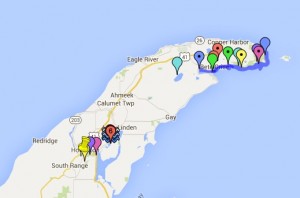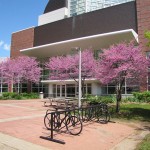 HOUGHTON — The Keweenaw Peninsula is a place of natural beauty with a fascinating mining history. Join local experts Bill Rose and Erika Vye in reading the landscape to learn how the Copper Country came to be the way it is today. In July Erika and Bill will lead one-day field trips exploring one of four major events in Earth’s history that make up the geology of the Keweenaw — Lavas, the Keweenaw Fault, the Jacobsville Sandstone, and Copper Mining Waste.
HOUGHTON — The Keweenaw Peninsula is a place of natural beauty with a fascinating mining history. Join local experts Bill Rose and Erika Vye in reading the landscape to learn how the Copper Country came to be the way it is today. In July Erika and Bill will lead one-day field trips exploring one of four major events in Earth’s history that make up the geology of the Keweenaw — Lavas, the Keweenaw Fault, the Jacobsville Sandstone, and Copper Mining Waste.
Cory Burkwald, a third-year Geology major, has been chosen to receive a Copper Club scholarship. The $10,000 award is for the 2016-17 school year.
Burkwald, a Naperville, Illinois native, also participates on Michigan Tech’s Cross Country and Track and Field teams.
Headquartered in New York City, the Copper Club Inc. is a leading organization for networking, educational grants and events for those who support the copper industry.
In a letter informing Burkwald of his scholarship, Andrew G. Kireta, Sr., executive director of the Copper Club, said, “through this program, the copper industry identifies and recognizes exceptional individuals who have excelled in the study of mining and metallurgy.”
Burkwald is Michigan Tech’s first recipient of a Copper Club Scholarship in the 20-year history of the award.
From Tech Today, by Geological and Mining Engineering and Sciences.
Ted Bornhorst, executive director A. E. Seaman Mineral Museum and professor, is co-author of a paper recently published by the international journal Economic Geology. The publication is a result of collaboration with Dr. Kei Ikehata of University of Tsukuba, Japan who is first author of the paper. The paper is titled “Hydrothermal Native Copper in Ocean Island Alkali Basalt from the Mineoka Belt, Boso Peninsula, Japan.” Additional co-authors are K. Chida and T. Tsunogae both at University of Tsukuba.
Michigan Tech Employee Service Recognition Event
On Wednesday, May 11, faculty and staff members, along with their guests, gathered at the Memorial Union Ballroom for an awards dinner recognizing 25, 30, 35 and 40 years of service to Michigan Tech. The following GMES faculty member was recognized:
25 Years
John Gierke, Geological & Mining Engineering & Sciences
Alesky Smirnow (GMES), is the principal investigator on a project that has received a $5,000 research and development agreement from the U.S. Department of the Interior, Geological Survey. The project is “Magnetic Petrophysics of the Menominee Iron Range.”
This is a two-year project.
Ted Bornhorst, executive director and professor, A. E. Seaman Mineral Museum recently attended the 62nd annual meeting of the Institute on Lake Superior Geology held in Duluth, Minnesota. The Institute includes geologic field trips as well as two days of technical presentations and posters. He served on the board of directors at its annual meeting. The 63rd annual meeting will be held in Wawa, Ontario and Bornhorst will be co-chair along with two Canadian colleagues.
This is the third year of one day geotours of Michigan’s Keweenaw based on four of the five Geoelements of Keweenaw Geoheritage. These tours use ground and boat transportation and visit some of the most scenic and important geological spots in the Keweenaw.
We use the University’s research vessel Agassiz. Individual trips include “Lavas and the Keweenaw Rift,” “The Keweenaw Fault,” “Jacobsville Sandstone” and “Mining Wastes of Lake Superior.” The trips are led by Bill Rose and Erika Vye, from Michigan Tech’s Geological Engineering department.
Details of these trips are described online. They feature places that can best be seen by boat. There are only 17 spaces on each trip — sign up early.
President Barack Obama honors Assistant Professor Colleen Mouw with the Presidential Early Career Award for Scientists and Engineers.
“These early-career scientists are leading the way in our efforts to confront and understand challenges from climate change to our health and wellness,” said President Obama.
All 106 recipients of the award are selected for their pursuit of innovative research at the frontiers of science and technology and their commitment to community service as demonstrated through scientific leadership, public education, or community outreach. The winners will receive their awards at a Washington, DC ceremony later this spring.
To read the official White House Press Release click here.
The National Science Foundation (NSF) posted a news story on its website about an open-vent volcano that erupted at Fuego, near Guatemala City. It quoted Greg Waite (GMES), who is studying the volcano under an NSF CAREER award.
Ted Bornhorst, executive director of the A.E. Seaman Mineral Museum and Dr. Chris Poulsen, chair of the department of Earth and environmental sciences at the University of Michigan, published an article titled: “Michigan Mineral Alliance” in the September issue of the international journal Rocks & Minerals. The article establishes a name for the legal agreement between Michigan Tech and the University of Michigan that provides for co-ownership and shared responsibility of the University of Michigan’s mineral collection. The collection is now at the museum and there is an introductory exhibit in the museum’s Thomas D. Shaffner exhibit hall.
Chad Deering (GMES) received a $77,039 grant from the National Aeronautics and Space Administration for a research and development project titled, Understanding Basaltic Volcanic Processes by Remotely Measuring the Links Between Vegetation Health and Extent, and Volcanic Gas and Thermal Emissions using HyspIRI-like VSWIR and TIR data. This is the first year of a potential two-year project totaling $212,448.
Aleksey Smirnov (GMES/EPSSI) received a $250,000 grant from the National Science Foundation for a research and development project titled, Paleointensity of the Paleoproterozoic Geomagnetic Field as Recorded by Single Silicate Crystals: Testing the “Proterozoic Dipole Low.” This is a three-year project.
GMES student Priscilla Addison received the Best Student Paper Award for “Rail Embankment Investigation Using Remote Sensing for a Permafrost Region” which she presented at the 2015 American Society of Civil Engineers (ASCE) Cold Regions Engineering Conference: Developing and Maintaining Resilient Infrastructure, held earlier this month in Salt Lake City. The thrust of Addison’s paper was to look at remote sensing as a site investigative tool for the portion of the Hudson Bay railway embankment underlain with discontinuous permafrost in northern Manitoba, Canada. This research is jointly supported by OmniTRAX Inc. and National University Rail (NURail) Center funded by the U.S Department of Transportation, Research and Innovative Technology Administration (USDOT-RITA). Addison is co-advised by Associate Professor Thomas Oommen (GMES) and Assistant Professor Pasi Lautala (CEE).
The US Peace Corps’ Peace Car was on the Michigan Tech campus July 9th. An eco-friendly Smart Car, the Peace Car enables Peace Corps staff to share their mission while limiting their carbon footprint. See the photo here
The Association of Engineering Geologists (AEG) featured Lauren Schaefer, a PhD student in Geological and Mining Engineering and Sciences, as its AEG Featured Scholar for June 2015.
Jason Gulley (GMES) has received a $194,940 research and development grant from the National Science Foundation for the collaborative research project: What Hydrogeochemical Processes Control Weathering in the Deep Critical Zone of Unburied Karst Landscapes. This is a two-year project.
 Bill Rose has started an effort to help get a local geoculture by doing a weekly department seminar. The idea is to have a partly technical and partly social event every friday from 3-4 (beginning Sept 4) with refreshments 4-5 pm.
Bill Rose has started an effort to help get a local geoculture by doing a weekly department seminar. The idea is to have a partly technical and partly social event every friday from 3-4 (beginning Sept 4) with refreshments 4-5 pm.
Speakers from the department and other parts of the university and beyond have been scheduled. All of these people want to communicate with our geocommunity. They all can help us by being part of our support group for teaching, research, outreach and learning in general. These are mostly people that we don’t see every day, but who know about the Earth, Earth Science, Geology, Geological Engineering, Geophysics and Mining. The seminars will be done to inform all of us about our geocommunity, its elements and opportunities.
You may realize that Michigan Tech is a geouniversity, created because of its fortunate geology. Many people are here, whether they realize it our not, because of Earth’s gifts here and our geoheritage. You, as a member of the geocommunity have advantages and benefits that you may not know about.
Among the main things that you could get out of participation in this seminar series are:
1. Being able to write a better proposal, that explains its relevance more broadly, something that could help you get funding.
2. You might be able to identify outside examiners for your MS or PhD research.
3. You might learn about a part of geoscience or engineering that could help you do better work, or understand things better.
4. You might improve at explaining your future to your grandmother.
5. It will be fun and interesting.
We hope you will want to come every friday! 3-5pm
See the Website http://www.geo.mtu.edu/~raman/SilverI/Geoseminar/Welcome.html
